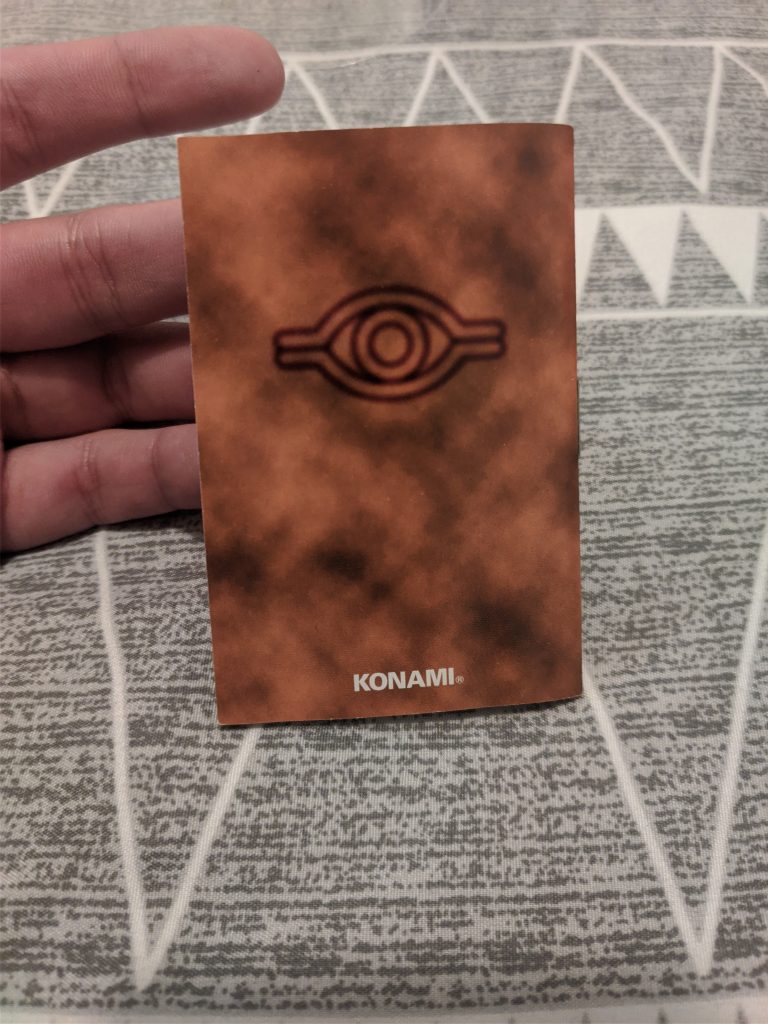February of 1999, the game looked just a little different.
Many people know that the TCG started 20 years ago in March of 2002. Many more have seen 1996 on their cards, but what’s rarely known is that the OCG started in 1999. The copyright date pertains to the manga and concept, but Konami’s card game, and what we know and love as a whole, started back on February 4th 1999.
The original Starter Box contained Star Chips, a playmat, a deck of cards, a calculator, and most relevantly, the first ever rulebook of the game. After securing one of these for myself, my team and I translated its contents to finally dispel any myths about the game’s origins. Below you will find a page-by-page transcript translated into English to show you exactly how Yu-Gi-Oh! was originally intended to be played, 3 years before Upper Deck would even print a card in the West.
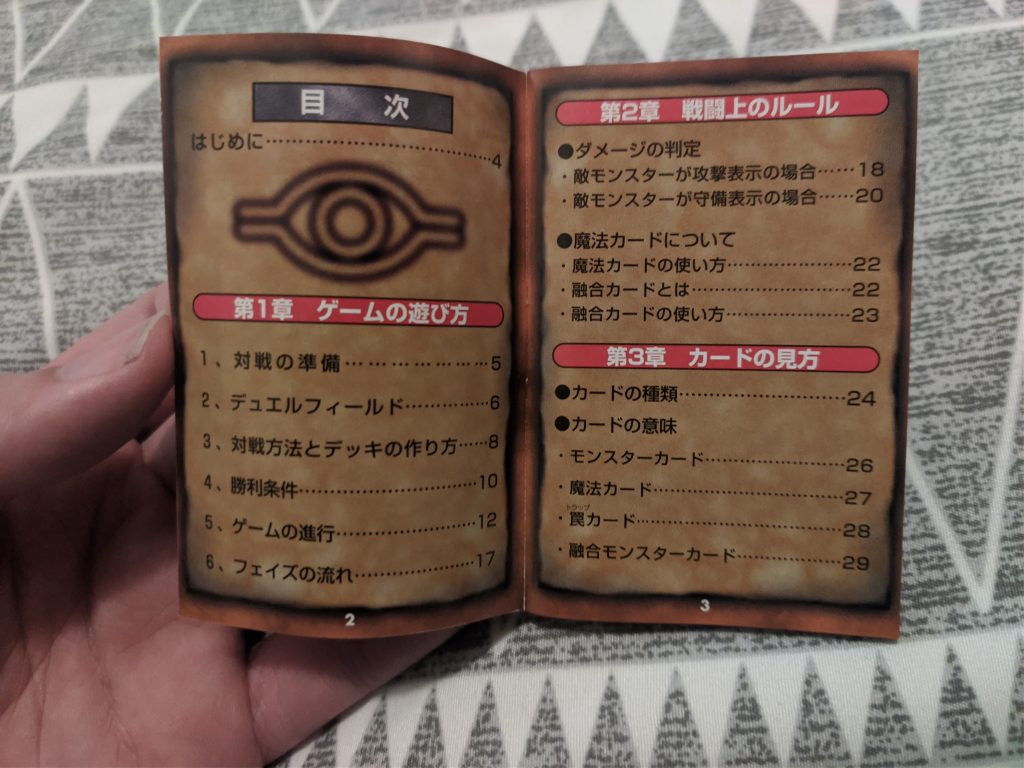
Cover (Page 1)
YU-GI-OH OFFICIAL CARD GAME
DUEL MONSTERS
OFFICIAL RULEBOOK
Page 2
INDEX
Starting – 4
CHAPTER 1 – HOW TO PLAY THE GAME
- Preparations for playing – 5
- Duel Field – 8
- How to Play and How to Make a Deck – 8
- Victory Conditions – 10
- Game Progression – 12
- Phase Progression – 17
Page 3
CHAPTER 2 – RULES FOR BATTLING
-Determining Damage
–If the opponent’s monster is in Attack Position – 18
–If the opponent’s monster is in Defense Position – 20
-About Spell Cards
–How to Use Spell Cards – 22
–About the Polymerization Card – 22
–How to Use Fusion Cards – 23
CHAPTER 3 – HOW TO READ CARDS
-Types of Cards – 24
-Card Information
–Monster Card – 26
–Spell Card – 27
–Trap Card – 28
–Fusion Monster Card – 29
Page 4
STARTING
YOU WILL BECOME THE TRUE DUEL MASTER!
“Yu-Gi-Oh! Official Card Game Duel Monsters” is a card game based on the card game appearing in the manga “Yu-Gi-Oh” currently being serialized in “Weekly Shonen Jump”.
This rulebook has information on what you need to play this game. Please thoroughly read and check these rules before playing the game.
There are a lot of different types of cards you can use in a game. You can use not only the cards included in the Starter Box, but also cards from Booster Packs you can purchase, as well as cards obtained from trading with your friends. Obtaining more cards will allow you to play more advantageously. Collecting cards is another part of what makes this game fun.
The Starter Box has various items in addition to this rulebook. These items make playing the game even more fun, so use them to your heart’s content. This rulebook will also touch on how to use these items.
Well then, please have Duels with your friends that won’t lose in intensity to those of Yugi and his friends.
Page 5
CHAPTER 1 HOW TO PLAY THE GAME
1. Preparations for Playing
You need the following items to play the game.
-Deck (containing at least 40 cards)
-Star Chip
-Duel Field
-Duel Score Sheet
-Duel Calculator
The Starter Box contains all of these items. Make sure you don’t lose them because you need them for the game.
Next you should look for a place suitable for playing. The Duel Field is of a considerable size, so make sure you find a location with enough room to play down the Duel Field as well as cards on top of it. In addition, play on a flat surface that isn’t too slippery, so that you don’t mix up you and your opponent’s cards.
Once everything’s ready, it’s time for Duel Start!
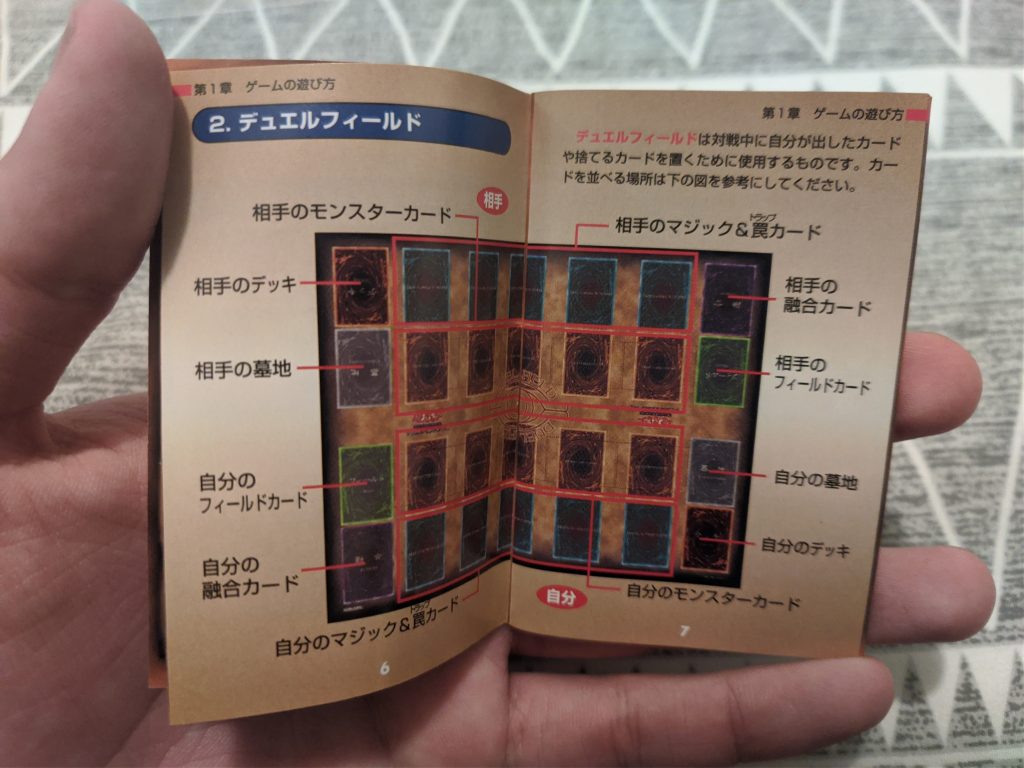
- Duel Field
The Duel Field is where you place your played cards and discarded cards. Please refer to the following picture on how to place cards.
(Opponent)
Opponent’s Monster Card | Opponent’s Magic & Trap Card
Opponent’s Deck | Opponent’s Fusion Cards
Opponent’s Graveyard | Opponent’s Field Card
Your Field Card | Your Graveyard
Your Fusion Cards | Your Deck
Your Magic & Trap Card | Your Monster Card
(You)
Page 8
- HOW TO PLAY AND HOW TO MAKE A DECK
-How to Play-
In order to play the game, please progress through the game following these Official Rules
- In this card game, a single game is called a Duel
- Three Duels decide the winner, and is called a Match
- The person who wins twice in a Match is the winner
- If the result ends up being “1 Win 2 Draws”, “1 Win 1 Loss 1 Draw”, or “3 Draws”, the Match itself is considered a draw
- The winner of a Duel gets to take the card their opponent bet, however, only do this if both players agreed to it before the Duel starts
- The card(s) obtained by winning each Duel cannot be used in the same Match
- The Match winner can obtain not just their opponent’s bet card, but also their Star Chips. However, only do this if both players have agreed to it before the Duel starts. Please come to an agreement on how many chips a player can win beforehand.
Page 9
Star Chips come in 3 varieties – Gold, Silver, and Bronze. Silver are worth 5 Bronze, and Gold are worth 10 Bronze.
-How to Make a Deck-
Your cards that you use each game are called your Deck. Please refer to these Official Rules on how to make your Deck.
1. The Deck you use in a game must be at least 40 cards, but there are no upper limits to how many you can have.
2. In addition to the Deck you’re using, you can also have 10 Preparation Cards set aside. This is called a Side Deck. The cards in a Side Deck can be swapped out with the cards in your Deck in between Duels to better suit your strategy.
Also, if your bet card was taken by your opponent and your Deck becomes less than 40 cards, you can use a card(s) from your Side Deck to make up the difference.
3. The maximum number of copies of each card you can have in your battling Deck and your Side Deck combined is 3.
Page 10
4. VICTORY CONDITIONS
Please refer to these Official Rules to determine the outcome of a Duel
1. Each Duel starts with each player having 8000 points. These points are called “Life Points”.
Life Points go down in various different conditions, such as when a player or monster takes an attack from their opponent, or fails a defense. If your opponent’s Life Points become 0, you win the Duel.
Please use the Duel Score Sheet included with the Starter Box to track the changing of Life Points. In addition, please use the Duel Calculator to correctly calculate this changing of points.
2. If each player’s Life Points reach 0 at the same time, the Duel is considered a draw.
In addition, if either player’s Deck is emptied and said player cannot draw anymore, the outcome of the Duel is decided by the remaining Life Points. In that case, the player with more Life Points at the moment said player’s Deck is emptied wins the Duel.
Page 11
3. If a player manages to gather all of the following cards in their hand, they win at that moment.
-Right Leg of the Forbidden One
-Left Leg of the Forbidden One
-Right Arm of the Forbidden One
-Left Leg of the Forbidden One
-Exodia the Forbidden One
It doesn’t matter if these cards are gathered at the starting hand, or during the course of a Duel; either way, the player wins.
(Personal note: These cards didn’t even exist yet.)
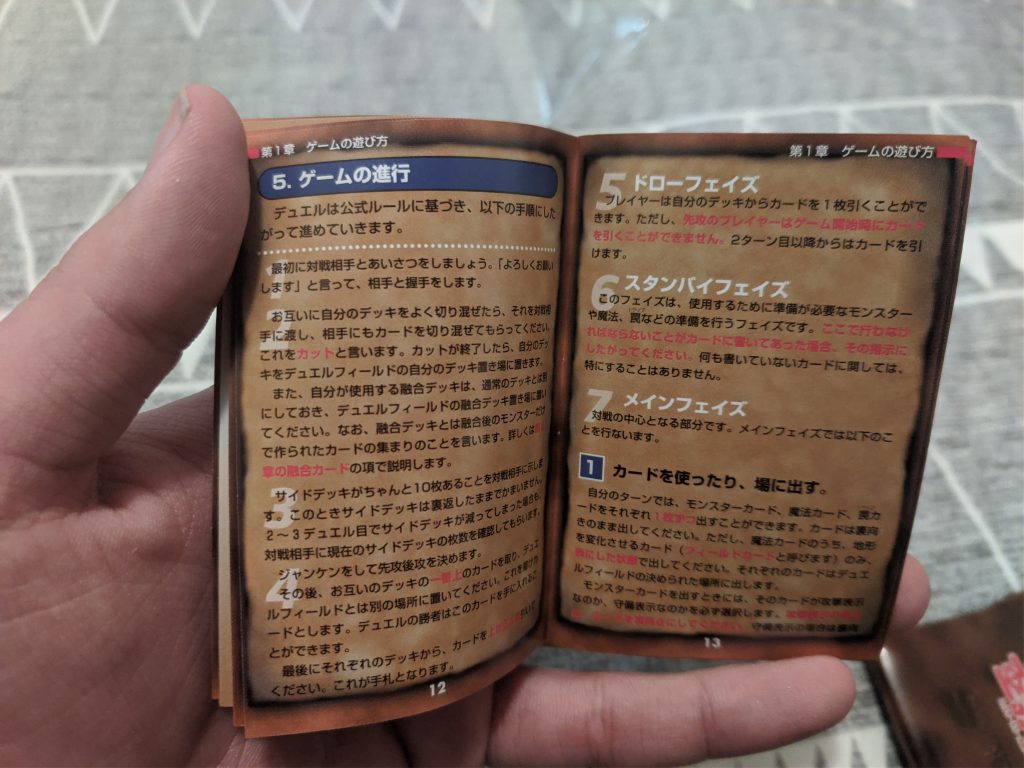
Page 12
5. PROGRESSION OF THE GAME
The game progresses based on these Official Rules
1. First make sure to greet your opponent, say a greeting to them and shake their hand.
2. Each player shuffles their Deck thoroughly, then hands their Deck to their opponent to have their opponent also shuffle their Deck thoroughly. This is called a cut. After the cutting is finished, place your own Deck on your own Duel Field in the Deck placement location.
In addition, separate your Fusion Deck from your normal Deck and place it on the Fusion Deck placement location on your Duel Field. The Fusion Deck is a gathering of only Fusion Monster Cards, and more information about them will be explained in Chapter 2 in the Fusion Card section.
3. Show to your opponent that your Side Deck contains exactly 10 cards. At this time you can do so with the cards face-down. If during Duel 2 or 3 your Side Deck number has gone down, make sure you show the current number of cards to your opponent.
4. Play a game of rock-paper-scissors to determine who goes first.
Then, each player takes the top card of their Deck and places it somewhere away from the Duel Field. These will become the bet cards. The winner of the Duel may take the bet card.
Finally, each player draws the top 5 cards of their Deck. These will become the players’ hands.
Page 13
5. Draw Phase
The turn player may draw 1 card from their Deck. However, the player going first cannot draw on their first turn. They may draw normally starting from their second turn.
6. Standby Phase
This is a Phase used by monsters, Spells, or Traps that need preparation. Follow what’s written on cards that mention they must use this phase. For cards that have no such text written, this phase does not concern them.
7. Main Phase
The main part of the game. You can do the following during the Main Phase.
[1] Use or Place a Card on the Field
During each of your turns, you may place 1 each of Monster Card, Spell Card, and Trap Card on the field. When you place a card on the field, always remember to place it face-down. However, there are Spell Cards that can change the terrain (called Field Cards) which must be placed on the field face-up instead. Place the cards on the field in their designated areas.
When you want to play a Monster Card, you must choose either Attack Position or Defense Position. If you choose Attack Position, you must play it face-up. If you choose Defense Position, the card remains face-down.
Page 14
Remember that you can only play up to 5 monsters.
From the second turn on, you can choose the position of monsters that have already been played on the Duel Field. For said monsters already on the field, you can change its position during this phase once per turn only. A monster whose position is changed like this cannot change its position again for the rest of this turn except in certain conditions.
You can only place up to 5 in combination of Spell Cards and Trap Cards on the field. Field Cards also count toward this 5 total. When you play these cards, you can place them face-up or face-down. However, if you place Spell Cards face-up, their effects activate. Follow the text on the Spell Cards on what to do. Also, the effect of the Spell Card only applies 1 time and disappears afterwards. However, cards that power up monsters and terrain-changing cards (Field Cards) behave differently. Trap Cards remain on the field unless otherwise specified.
When you use a type of Spell Card that powers up monsters, play it face-up, and stack it on top of the target monster. However, this card is still treated as being placed on the field and counts toward the 5 card total.
You can also fuse monsters during this phase.
[2] Going into Battle (Battle Phase)
During your Main Phase, you can conduct a battle against your opponent for 1 time only. This is called a Battle Phase.
Page 15
At this point, the turn player can attack with monsters they have played on to the Duel Field. However, the Battle Phase is not something you must conduct, and is entirely up to the digression of the player.
Any number of monsters in Attack Position on the field can join in the attack. When doing so, if the opponent has any monsters placed on the field, that monster(s) become the attack target. If your opponent has any monsters placed on the field, you cannot attack them directly.
In addition, while it’s possible to play a Monster Card on the field on turn 1, it is not possible to attack. Attacking becomes possible starting from turn 2. Also, Spell Cards placed on the field other than Trap Cards cannot be used during the Battle Phase. [<– YGOrg editor note: Yes, that last sentence is literally what the rulebook says.]
The flow of attacking monsters goes as follows.
First declare you are going into the Battle Phase. Then, the turn player decides which of their monsters is attacking, and which of their opponent’s monsters will be attacked. If the opponent has no monsters placed on the field, the attack target becomes the opponent.
However, each individual monster can only attack 1 monster or 1 player. A singular monster cannot attack multiple monsters, and a monster that has already attacked cannot attack again during the same turn.
After the first battle is over, the attacking player can choose the next monster to battle.
Page 16
This can be repeated as many times as the number of monsters the player has placed on the field.
However, it is not necessary for every monster in Attack Position to attack. You can decide what monsters to attack with and what not to, depending on the situation.
If you are attacking an opponent’s monster in Defense Position, turn that card face-up so that card’s data can be seen for the attack.
A used Spell Card, or destroyed monster or Trap Card, is placed in the Graveyard on the Duel Field. Outside of special circumstances, these cards cannot be used again in the Duel.
Even when the Battle Phase is over, as long as you do not move to the End Phase, it remains the Main Phase.
8. End Phase
Declare to your opponent that your turn is over, and move the turn over to your opponent.
7. Duel Ends
Repeat the steps from the Draw Phase to the End Phase until a victor is decided. When the opponent’s points reach 0, the victor is decided and the Duel ends.
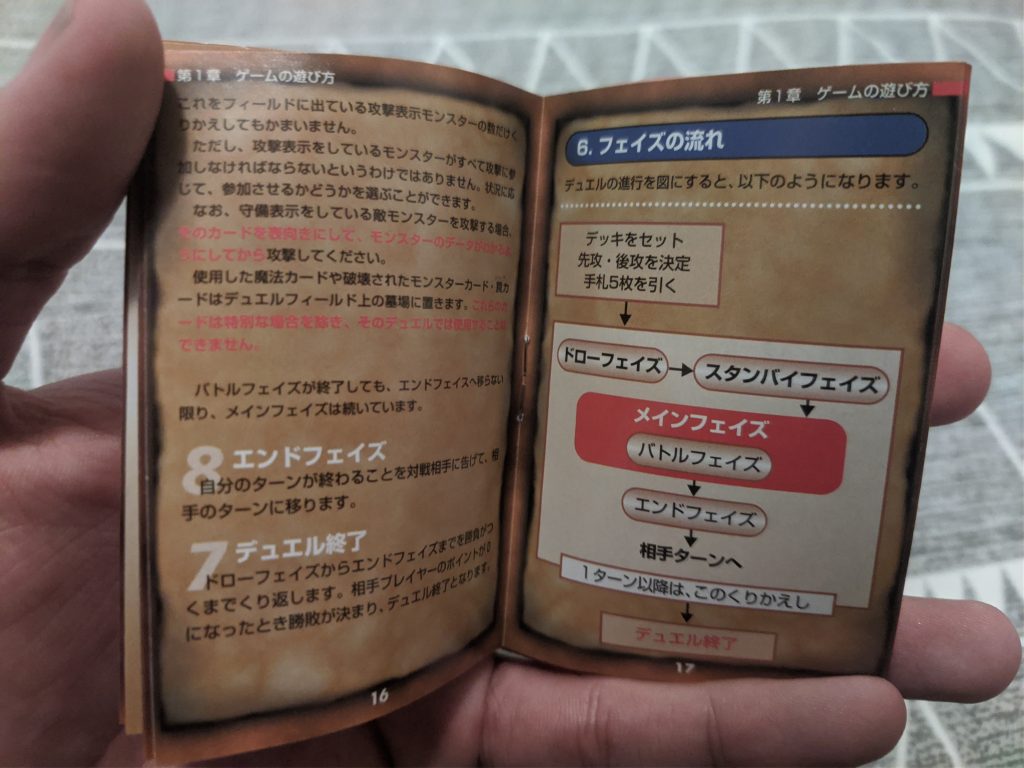
Page 17
6. Flow of the Phases
Here is a diagram of the flow of the Duel
[Set the Decks]
[Decide the order]
[Draw 5 cards for the hands]
. |
(Draw Phase) → Standby Phase
. |
. [MAIN PHASE]
. (Battle Phase)
. |
. (End Phase)
. |
. Opponent’s Turn
Repeat this process after turn 1
. |
. Duel Ends
Page 18
CHAPTER 2 BATTLING RULES
Determining Damage
Determine the damage for battling monsters during the Duel with these Official Rules
1. If the opponent’s monster is in Attack Position
If the monster you are attacking is in Attack Position, the damage is determined by comparing Attack Power.
-IF YOUR ATTACK POWER IS GREATER THAN THE OPPONENT’S ATTACK POWER
At that point, the [Attacking Monster’s Attack Power] minus the [Attacked Monster’s Attack Power] is inflicted to your opponent’s Life Points. Please use the Duel Calculator included in the Starter Box to calculate this.
Page 19
-IF YOUR ATTACK POWER IS EQUAL TO THE OPPONENT’S ATTACK POWER
If your attacking monster’s attack power is the same as the attacked monster’s attack power, both monsters are destroyed.
At that point, neither the attacking player nor the opponent takes any damage and there will be no changes to Life Points.
-IF YOUR ATTACK POWER IS LOWER THAN THE OPPONENT’S ATTACK POWER
If your attacking monster’s attack power is lower than the opponent’s attack power, your attacking monster is destroyed.
At that point, the [Attacked Monster’s Attack Power] minus the [Attacking Monster’s Attack Power] is inflicted to the attacking player’s Life Points. Please use the Duel Calculator included in the Starter Box to calculate this.

Page 20
2. If the opponent’s monster is in Defense Position
If the monster you’re attacking is in Defense Position, the damage is determined by comparing the attacking monster’s Attack Power with the attacked monster’s Defense Power.
-IF YOUR ATTACK POWER IS GREATER THAN THE OPPONENT’S DEFENSE POWER
If the attacking monster’s Attack Power is higher than the attacked monster’s Defense Power, the attacked monster is destroyed.
In that case, neither the attacking player nor the opponent takes any damage. There will be no changes to Life Points.
-IF YOUR ATTACK POWER IS EQUAL TO THE OPPONENT’S DEFENSE POWER
If the attacking monster’s Attack Power is equal to the attacked monster’s Defense Power, neither player’s monster will be damaged..
Also, neither the attacking player nor the opponent takes any damage. There will also be no changes to Life Points.
Page 21
-IF YOUR ATTACK POWER IS LOWER THAN THE OPPONENT’S DEFENSE POWER
If the attacking monster’s Attack Power is lower than the attacked monster’s Defense Power, neither monster will be damaged.
At that point, the [Attacked Monster’s Defense Power] minus the [Attacking Monster’s Attack Power] is inflicted to the attacking player’s Life points. Please use the Duel Calculator included in the Starter Box to calculate this.
If the opponent has no monsters on the Duel Field, the damage is delivered directly to the opponent.
Also, make sure to place monsters destroyed by battle and used Spell Cards in the Graveyard on the Duel Field.
Page 22
ABOUT SPELL CARDS
1. How to Use Spell Cards
Spell Cards that power up monsters are placed on the field stacked on top of the Monster Card on the Duel Field. Also, normally, only face-up Monster Cards can be powered up by this type of Spell Card. They must be used on appropriate monsters. Please make sure to follow what’s written on the cards to see what monster cards they can be used on.
There are Spell Cards that can change the terrain. These are called Field Cards. Only 1 Field Card can be on the Duel Field at the same time. The newest card placed on the field is the one that takes effect.
2. About the Polymerization Card
Fusion is the rule of calling out and using a new monster via 2 of your monster cards and 1 Polymerization Card. Polymerization is a type of Spell Card. Monsters that can fuse and monsters that can be fused into are all predetermined.
Monsters that can fuse are specifically shown on the cards of monsters that can be brought out by fusing (this is called a Fusion Monster Card). Please perform Fusion by following the information on each card.
Page 23
How to Use Polymerization
This is an explanation for the process of Fusion. Please follow these steps to perform Fusions.
1. When you have Monster A and Monster B on the Duel Field, and have the Polymerization card in your hand, you can place it from your hand on to the Spell & Trap Card placement location on the Duel Field and declare you are performing a Fusion.
2. Search your Fusion Deck for a Monster C that can be fused by Monsters A and B and place it on the Monster Card placement location on the Duel Field.
The Fusion Deck is a separate group of cards consisting of only fused monsters. When you are performing a Fusion, the fused monster is chosen from this Fusion Deck instead of your normal Deck. The battling Deck and the Fusion Deck are separate. Please place it on the Fusion Deck placement location on the Duel Field.
3. Place Monster A, Monster B, and the Polymerization card used for this Fusion in the Graveyard.
The steps above must be followed in order to perform a Fusion.
Page 24
CHAPTER 3 HOW TO READ CARDS
Types of Cards
This game uses the following types of cards
1. Monster Card
Monster Cards are basic cards you use to attack the opponent. Monster Cards are differentiated into Types and Attributes. There are 20 Types and 6 Attributes.
A Type describes what kind of creature that monster is, while an Attribute describes the essence of the monster. Monsters’ abilities vary depending on their Type and Attribute, and affect stats such as Attack Power and Defense Power.
For more details about this please check the cards themselves.
TYPE
Dragon Spellcaster Zombie Warrior Beast-Warrior
Beast Winged Beast Fiend Fairy Insect Dinosaur Reptile Fish
Sea Serpent Machine Thunder Aqua Pyro Rock Plant
ATTRIBUTE
Earth Water Fire Wind Light Dark
Page 25
2. Fusion Monster Card
Fusion Monster Cards are special Monster Cards created by Fusion. Their basic abilities are not different from Monster Cards, but the way to use them is different from regular Monster Cards.
3. Spell Card
Spell Cards have a variety of types, ranging anywhere from destroying monsters to dissipating an opponent’s curse. The most representative types are Spell Cards which you use when attempting to cast magic, and Field Cards which you use to change the terrain.
[Spell Card]
A type of card that can do things such as inflicting damage to your opponent or recover Life Points. Except for the type of cards that power-up monsters or Field Cards, these cards are destroyed after use, and cannot be used again.
[Field Card]
A type of card that can change the terrain of battle on the field. There are many types, some examples include Mountain, Sea, Darkness, or Grasslands. When a Field Card is played on the Duel Field, the Field gets changed to the terrain depicted on the card. The terrain affects monsters and changes their Attack Power and Defense Power.
In addition, a Field Card’s effect remains active until it is overridden by another Field Card.
4. Trap Card
Generally a type of card that supports monsters during battles. For more information, refer to the cards themselves.

Page 26
Card Information
MONSTER CARD
Monster Name Attribute
Level
Type Attack Power
Monster Ability Defense Power
Page 27
SPELL CARD
Spell Name Card Type
Effect of the Spell
Page 28
TRAP CARD
Trap Name Card Type
Effect of the Trap
Page 29
FUSION MONSTER CARD
Monster Name Attribute
Level
Type Attack Power
Monsters Used for Fusion Defense Power
